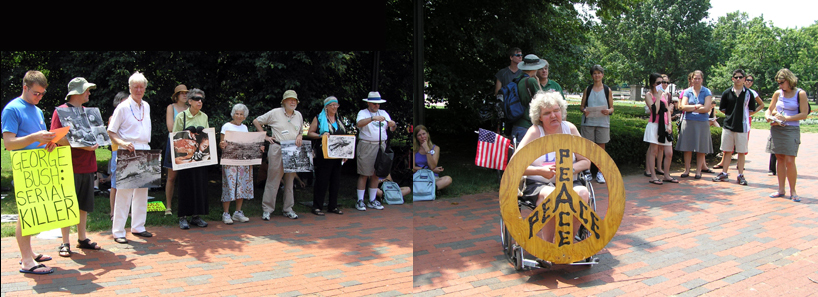LOS ALAMOS, N.M. -- At the birthplace of the atomic bomb, outside the national labs that feed today's nuclear arsenal, and in nation's capital, survivors of the deadly blasts that devastated Hiroshima and Nagasaki 60 years ago joined hundreds of activists Saturday in support of a global ban on nuclear weapons.
"No more Hiroshimas. No more Nagasakis," bombing survivor Koji Ueda wrote in a statement distributed at a rally in the Los Alamos park that had held research laboratories when the Manhattan Project developed the world's first atomic bomb.
"We send this message to our friends all over the world, along with a fresh determination of the 'hibakusha' (atomic bomb survivors) to continue to tell about Hiroshima and Nagasaki, aiming at a planet set free of wars of nuclear weapons," Ueda said.
In Oak Ridge, Tenn., 15 protesters from a group of more than 1,000 were arrested Saturday for blocking a road outside the heavily guarded weapons factory that helped fuel the bomb during World War II.
At the Nevada Test Site, peace activists discussed ways to eliminate nuclear weapons. While in California, hundreds of activists marched to the gates of Lawrence Livermore National Laboratory, some holding sunflowers and others hoisting a 40-foot inflatable "missile."
The city of Hiroshima, meanwhile, marked the anniversary with prayers and water for the dead.
At 8:15 a.m., the instant of the blast, Hiroshima's trolleys stopped and more than 55,000 people at Peace Memorial Park observed a moment of silence that was broken only by the ringing of a bronze bell.
Ueda, who was 3 when the bomb was dropped on Hiroshima, was joined at Los Alamos by Masako Hashida, who was 15 and working in a factory a mile from where the second bomb fell three days later on Nagasaki.
In an interview with The Associated Press, Hashida recalled hearing a loud metallic noise and then seeing waves of red, blue, purple and yellow light. She said she lost consciousness and awoke outside the twisted metal ruins of the factory, which had made torpedoes used in the attack on Pearl Harbor.
She saw a person trying to stand, with burns and swelling so severe it was impossible to tell if it was a man or a woman.
In the Los Alamos park where research laboratories stood during the Manhattan Project, placards carried anti-war slogans including "No More War for Oil and Empire" and "We're sorry about Hiroshima and Nagasaki."
A group of veterans offered an opposing message across the park from the more than 500 activists. One sign read: "If there hadn't been a Pearl Harbor, there wouldn't have been a Hiroshima."
Steve Stoddard, 80, of Los Alamos, said the group was trying to counter the "demonizing of the bomb."
"We feel the bomb saved our lives," said Stoddard, a World War II veteran who fought in Europe. He believes he would have been sent to fight in Japan had the bombs not ended the war when they did.
In Washington, G.R. Quinn, 54, of Bethesda, Md., held a sign across from the White House reading: "God Bless the Enola Gay," referring to the B-29 that dropped the first bomb.
